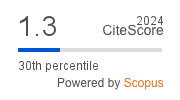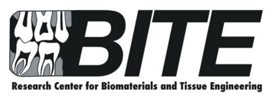Ethanol extract of Imperata Cylindrica leaves inhibits proliferation and migration of HSC-3 cell lines
Downloads
Background: Squamous cell carcinoma (SCC) is classified as the most common type of oral cancer up to 90% of all malignant neoplasm in the oral cavity. Currently, the only treatments for SCC are surgery and/or radiation or chemotherapy, which can cause various side effects. Cogon grass leaves (Imperata cylindrica) have been considered an alternative cancer treatment that may reduce side effects. Imperata cylindrica (I. cylindrica) leaf extract can inhibit cancer cell proliferation and migration by withholding the cell cycle in the gap 1/synthesis (G1/S) and gap 2/mitosis (G2/M) phases. Therefore, the levels of matrix metalloproteinase-2 (MMP-2) and matrix metalloproteinase-9 (MMP-9) is decreased and cancer is not progressing. Purpose: The study aims to determine the effect of I. cylindrica leaf extract on the proliferation and migration of human oral squamous carcinoma-3 (HSC-3) cell lines. Methods: This in vitro experimental study was conducted with nine study groups. The treatment group was divided into seven concentrations”640 ppm, 320 ppm, 160 ppm, 80 ppm, 40 ppm, 20 ppm and 10 ppm. 3-(4,5-dimethyl-2-thiazolyl)-2,5-diphenyl-2H-tetrazolium-bromide (MTT) assay and scratch assay were carried out to assess the effect of I. cylindrica leaf extract on HSC-3 cell proliferation and migration. Results: Ethanol extract of I. cylindrica has a significant effect compared to the negative control towards the proliferation and migration of HSC-3 cells. Conclusion: This study shows that I. cylindrica ethanol leaf extract can inhibit proliferation and migration of HSC-3 cells.
Downloads
Johnson NW, Jayasekara P, Amarasinghe AA. Squamous cell carcinoma and precursor lesions of the oral cavity: epidemiology and aetiology. Periodontol 2000. 2011; 57(1): 19–37.
Bilgic O, Duda L, Sánchez MD, Lewis JR. Feline oral squamous cell carcinoma: clinical manifestations and literature review. J Vet Dent. 2015; 32(1): 30–40.
Pires FR, Ramos AB, Oliveira JB, Tavares AS, Luz PS, Santos TC. Oral squamous cell carcinoma: clinicopathological features from 346 cases from a single oral pathology service during an 8-year period. J Appl Oral Sci. 2013; 21(5): 460–7.
Bray F, Ferlay J, Soerjomataram I, Siegel RL, Torre LA, Jemal A. Global cancer statistics 2018: GLOBOCAN estimates of incidence and mortality worldwide for 36 cancers in 185 countries. CA Cancer J Clin. 2018; 68(6): 394–424.
Huang SH, O'Sullivan B. Oral cancer: current role of radiotherapy and chemotherapy. Med Oral Patol Oral Cir Bucal. 2013; 18(2): e233–40.
Al-Koshab M, Alabsi AM, Mohd Bakri M, Ali-Saeed R, Selvi Naicker M. Antitumor activity of Ficus deltoidea extract on oral cancer: an in vivo study. J Oncol. 2020; 2020: 5490468.
Hassabou NF, Farag AF. Anticancer effects induced by artichoke extract in oral squamous carcinoma cell lines. J Egypt Natl Canc Inst. 2020; 32: 17.
Fatmawati S. Bioaktivitas dan konstituen kimia tanaman obat Indonesia. Yogyakarta: Deepublish; 2019. p. 181.
Mbaveng AT, Kuete V, Efferth T. Potential of central, eastern and western Africa medicinal plants for cancer therapy: spotlight on resistant cells and molecular targets. Front Pharmacol. 2017; 8: 343.
Quintero-Fabián S, Arreola R, Becerril-Villanueva E, Torres-Romero JC, Arana-Argáez V, Lara-Riegos J, Ramírez-Camacho MA, Alvarez-Sánchez ME. Role of matrix metalloproteinases in angiogenesis and cancer. Front Oncol. 2019; 9: 1370.
Ma D, Fang J, Liu Y, Song JJ, Wang YQ, Xia J, Cheng B, Wang Z. High level of calpain1 promotes cancer cell invasion and migration in oral squamous cell carcinoma. Oncol Lett. 2017; 13(6): 4017–26.
Tessalonica S, Roeslan MO. Effect of ethanol extracts from Persea americana leaves on HSC-3 proliferation. J Indones Dent Assoc. 2020; 3(2): 65–70.
Roghini R, Vijayalakshmi K. Phytochemical screening, quantitative analysis of flavonoids and minerals in ethanolic extract of Citrus paradisi. Int J Pharm Sci Res. 2018; 9(11): 4859–64.
Hossain MA, AL-Raqmi KA, AL-Mijizy ZH, Weli AM, Al-Riyami Q. Study of total phenol, flavonoids contents and phytochemical screening of various leaves crude extracts of locally grown Thymus vulgaris. Asian Pac J Trop Biomed. 2013; 3(9): 705–10.
Das BK, Al-Amin MM, Russel SM, Kabir S, Bhattacherjee R, Hannan JMA. Phytochemical screening and evaluation of analgesic activity of Oroxylum indicum. Indian J Pharm Sci. 2014; 76(6): 571–5.
Riss TL, Moravec RA, Niles AL, Duellman S, Benink HA, Worzella TJ, Minor L. Cell viability assays. In: Markossian S, Grossman A, Brimacombe K, Arkin M, Auld D, Austin CP, Baell J, Chung TDY, Coussens NP, Dahlin JL, Devanarayan V, Foley TL, Glicksman M, Hall MD, Haas J V, Hoare SRJ, Inglese J, Iversen PW, Kales SC, Lal-Nag M, Li Z, McGee J, McManus O, Riss T, Xu X, editors. Assay guidance manual. Bethesda (MD): Eli Lilly & Company and the National Center for Advancing Translational Sciences; 2004-; 2016. p. 1–25.
Roeslan MO, Ayudhya TDN, Yingyongnarongkul BE, Koontongkaew S. Anti-biofilm, nitric oxide inhibition and wound healing potential of purpurin-18 phytyl ester isolated from Clinacanthus nutans leaves. Biomed Pharmacother. 2019; 113: 108724.
Isah T. Anticancer alkaloids from trees: development into drugs. Pharmacogn Rev. 2016; 10(20): 90–9.
Romagnolo DF, Selmin OI. Flavonoids and cancer prevention: a review of the evidence. J Nutr Gerontol Geriatr. 2012; 31(3): 206–38.
Stoddart MJ. Cell viability assays: Introduction. In: Stoddart M, editor. Mammalian cell viability Methods in molecular biology (Methods and protocols), vol 740. Humana Press; 2011. p. 1–6.
Keshava R, Muniyappa N, Gope R, Ramaswamaiah AS. Anti-cancer effects of Imperata cylindrica leaf extract on human oral squamous carcinoma cell line SCC-9 in vitro. Asian Pacific J cancer Prev. 2016; 17(4): 1891–8.
Kwok AH, Wang Y, Ho WS. Cytotoxic and pro-oxidative effects of Imperata cylindrica aerial part ethyl acetate extract in colorectal cancer in vitro. Phytomedicine. 2016; 23(5): 558–65.
Cory G. Scratch-wound assay. In: Wells CM, Parsons M, editors. Cell migration Methods in molecular biology (Methods and protocols), vol 769. Humana Press; 2011. p. 25–30.
Kim DH, Xing T, Yang Z, Dudek R, Lu Q, Chen YH. Epithelial mesenchymal transition in embryonic development, tissue repair and cancer: a comprehensive overview. J Clin Med. 2017; 7(1): 1–25.
Yang F, Ma J, Wan J, Ha W, Fang C, Lu H, Zhang W. Epithelial-mesenchymal transition of circulating tumor cells in prostate cancer is promoted by survivin. J Int Med Res. 2020; 48(1): 300060519892395.
Ravishankar D, Rajora AK, Greco F, Osborn HM. Flavonoids as prospective compounds for anti-cancer therapy. Int J Biochem Cell Biol. 2013; 45(12): 2821–31.
Panche AN, Diwan AD, Chandra SR. Flavonoids: an overview. J Nutr Sci. 2016; 5: e47.
Chan LP, Chou TH, Ding HY, Chen PR, Chiang FY, Kuo PL, Liang CH. Apigenin induces apoptosis via tumor necrosis factor receptor- and Bcl-2-mediated pathway and enhances susceptibility of head and neck squamous cell carcinoma to 5-fluorouracil and cisplatin. Biochim Biophys Acta - Gen Subj. 2012; 1820(7): 1081–91.
Meng S, Zhu Y, Li JF, Wang X, Liang Z, Li SQ, Xu X, Chen H, Liu B, Zheng XY, Xie LP. Apigenin inhibits renal cell carcinoma cell proliferation. Oncotarget. 2017; 8(12): 19834–42.
Ham S, Kim KH, Kwon TH, Bak Y, Lee DH, Song YS, Park SH, Park YS, Kim MS, Kang JW, Hong JT, Yoon DY. Luteolin induces intrinsic apoptosis via inhibition of E6/E7 oncogenes and activation of extrinsic and intrinsic signaling pathways in HPV-18-associated cells. Oncol Rep. 2014; 31(6): 2683–91.
Stephane FFY, Jules BKJ. Terpenoids as important bioactive constituents of essential oils. In: Essential oils - Bioactive compounds, new perspectives and applications. IntechOpen; 2020. p. 1–32.
Ammoury C, Younes M, El Khoury M, Hodroj MH, Haykal T, Nasr P, Sily M, Taleb RI, Sarkis R, Khalife R, Rizk S. The pro-apoptotic effect of a Terpene-rich Annona cherimola leaf extract on leukemic cell lines. BMC Complement Altern Med. 2019; 19: 365.
Wang P, Wang P, Liu B, Zhao J, Pang Q, Agrawal SG, Jia L, Liu FT. Dynamin-related protein Drp1 is required for Bax translocation to mitochondria in response to irradiation-induced apoptosis. Oncotarget. 2015; 6(26): 22598–612.
Gruver-Yates AL, Cidlowski JA. Tissue-specific actions of glucocorticoids on apoptosis: a double-edged sword. Cells. 2013; 2(2): 202–23.
Kim LH, Khadka S, Shin JA, Jung JY, Ryu MH, Yu HJ, Lee HN, Jang B, Yang IH, Won DH, Kwon HJ, Jeong JH, Hong SD, Cho NP, Cho SD. Nitidine chloride acts as an apoptosis inducer in human oral cancer cells and a nude mouse xenograft model via inhibition of STAT3. Oncotarget. 2017; 8(53): 91306–15.
Xu W, Wang X, Tu Y, Masaki H, Tanaka S, Onda K, Sugiyama K, Yamada H, Hirano T. Tetrandrine and cepharanthine induce apoptosis through caspase cascade regulation, cell cycle arrest, MAPK activation and PI3K/Akt/mTOR signal modification in glucocorticoid resistant human leukemia Jurkat T cells. Chem Biol Interact. 2019; 310: 108726.
- Every manuscript submitted to must observe the policy and terms set by the Dental Journal (Majalah Kedokteran Gigi).
- Publication rights to manuscript content published by the Dental Journal (Majalah Kedokteran Gigi) is owned by the journal with the consent and approval of the author(s) concerned.
- Full texts of electronically published manuscripts can be accessed free of charge and used according to the license shown below.
- The Dental Journal (Majalah Kedokteran Gigi) is licensed under a Creative Commons Attribution-ShareAlike 4.0 International License

















